An "O" consists of dancers occupying the following spots in a 4 x 4 matrix:
|
"O" FORMATION
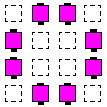
| |

| | From here... | | imagine you are here. |
|
An "O" is considered to be Distorted Columns,
as if the Centers slid apart from normal Columns.
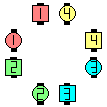
| |

| | If you are here... | | think of working
in Columns |
|

| |
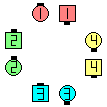
| before
"O" Circulate | | after
|
|
|
|
Notes:
-
For simple calls (such as "O" Circulate, "O" Split Counter Rotate 1/4,
etc.) move directly to your ending footprints. For more complex calls,
start the call working distorted, blend into a
normal setup, complete the call normally, and then have the resulting
Centers move away from the Center to re-establish the "O" footprints.
-
If dancers occupy "O" footprints but the caller wishes them to
work in distorted Parallel Lines, the term
Big Block [C3A]
is used.
-
Sometimes the caller wants you to start the call in your "O" but
finish in a normal setup. In these cases the caller will add a suffix
such as 'To Normal Waves', 'To A Line', 'To Columns', etc.
(e.g., "O" Checkmate To Normal Lines).
-
An "O" can also be
T-Bone
in which case you do your part working in your own set of distorted Columns.
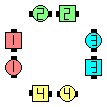
| |

| |

| | From here... | | imagine you are here... | | ... or here. |
|
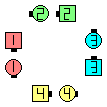
| |
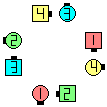
| before
"O" Walk & Dodge | | after
|
|
Mini-"O" FORMATION [C1V]:
A Mini-"O" is a 6-dancer "O" with 2 Centers and 4 Ends.
|
Mini-"O" FORMATION

| |

| | Mini-"O" | | think of working here |
|
See also Butterfly FORMATION [C1]
and Squeeze [C1].